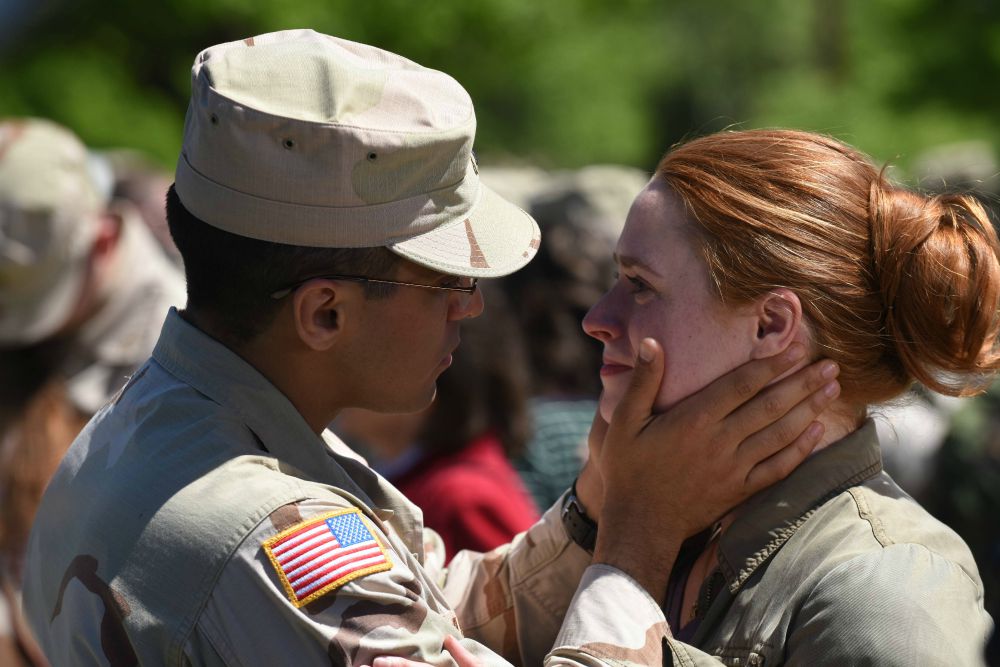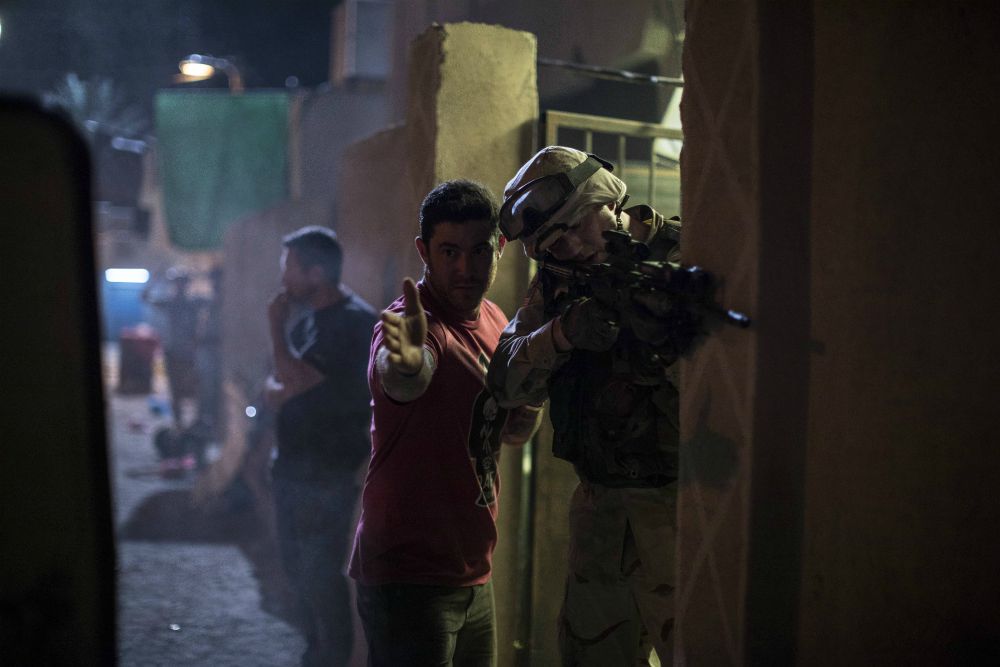
E.J. Bonilla as Lt. Shane Aguero and Katie Paxton as Amber Aguero on the set of "The Long Road Home" at U.S. Military post, Fort Hood, Killeen, Texas (National Geographic/Van Redin)
National Geographic's second scripted series is an eight-part miniseries starring Michael Kelly, Jason Ritter, E.J. Bonilla, Kate Bosworth, Patrick Schwarzenegger and Jeremy Sisto. It tells a tragic and sobering story: the eight-hour siege at Sadr City, a Bagdad neighborhood, on "Black Sunday," April 4, 2004.*
Based on correspondent Martha Raddatz's New York Times best-selling book, The Long Road Home, the series of the same name is an emotional ride through the horrific experiences and heroic actions of the U.S. Army's 1st Calvary Division when they were ambushed while helping local citizens to drain sewage.
The troops are newly arrived in Iraq when newly acting battalion commander Lt. Col. Gary Volesky (Kelly) sends the convoy in to what they assume to be a peaceful place. The men are mostly young and inexperienced; they worry about ever having to kill a child.
Before leaving Ft. Hood in Texas they take leave of their families. Cindy Sheehan (Rochelle Robinson), the mother of Pfc. Pat Sheehan (Danny Camp) accosts Kelly and his wife, demanding to know why the army is sending troops to Iraq. He patiently explains that they are going to spread peace and build the country. Kelly really seems to believe what he's saying. Sheehan wants to believe him and demands that he bring her son home alive. Kelly promises.
Advertisement
Kelly's wife LeAnn (Sarah Wayne Callies) heads up the family support group (Family Readiness Group) aided by Gina Denomy (Bosworth) who is new to Ft. Hood. Their task is to keep the wives and families informed of what's going on with the troops and in the case of death or injury, to bring comfort and solace. LeAnn is strong and confident; she's been doing this for a long time. Gina has a newborn, seems to suffer from doubt and perhaps a little depression, but rises to the occasion.
You can go to the National Geographic website and get an overview through a series of trailers that show the high production quality and realism of the story of a battle that took the lives of eight soldiers and injured 65 others. If you watch the entire series, you will see the tragic and heroic decisions they had to make to survive.
The 1st Calvary Division was a band of brothers who took care of each other, and this is what Raddatz wants to covey. (She wrote for all the episodes with other co-writers.) But she does not sidestep the looming questions of the legitimacy of the invasion of Iraq, the horrors of war, causes of post-traumatic stress disorder, the suffering on the home front, and the creeping, deepening sense of death and loss to come.

Mike Baumgarten (tactical military advisor) trains a cast soldier on set of "The Long Road Home" at U.S. Military post, Fort Hood, Killeen, Texas. (National Geographic/Jeremy Benning)
The series is honest. By including Cindy Sheehan, who became an anti-war activist after her son's death in Iraq, Raddatz questions the legitimacy of the war in Iraq, and rightly so. Yet this honesty includes the humanity and heroism of these men who believe they are there to do something good. The honest view of this tragedy, which the series allows, is that if any good did happen it was a miracle for this band of brothers that should never have been in this situation, in a senseless war that should never have happened.
Because the Army did not think there was any more danger from insurgents at the time, they did not send armored vehicles with the 1st Calvary Division to Iraq; the U.S. government believed it had won the hearts and minds of the people, but the government was wrong. When more troops were sent in riding in Humvees to rescue the troops who had been ambushed, neither the vehicles nor men were equipped with basic radios to communicate with each other. It was a disaster just waiting to happen.
If you choose to watch "The Long Road Home," be prepared to feel something of what the troops may have felt and experienced, from a joyful, patriotic send-off to tragic results. Staff Sgt. Robert Miltenberger (Sisto), who was older than most of the men, has had a premonition of death yet he continues on, cloaked in predestined doom. Sgt. Eric Bourquin (Jon Beavers) is the scary one; he seems to have a cruel streak and is suspicious of their interpreter. His character's "journey" throughout these eight hours is probably longer than what is depicted, and what happens with his character is deeply meaningful.
This is a story as old as modern warfare and as cruel and nonsensical as most modern warfare has proven to be. A group of unassuming soldiers are trapped in a relatively small corner of hell; you can decide who was responsible for creating it. The characters will engage your empathy in numerous ways, true, but I was not uplifted by the series. It made me grieve the loss of so many thousands of U.S. military members and tens of thousands of local Iraqi people through "collateral damage."
The performances are strong; I especially liked Bonilla as Lt. Shane Aguero, the first soldier we meet. However, I thought that Callies' and Bosworth's characters lacked dimensionality.
This eight-part series mirrors the eight hours of the battle to free the 1st Calvary Division in Sadr City almost 14 years ago. Somehow, it seems all too present.
* An earlier version of this article misstated the number of scripted series National Geographic has produced.
[Sr. Rose Pacatte, a member of the Daughters of St. Paul, is the director of the Pauline Center for Media Studies in Los Angeles.]

Darius Homayoun-Jassim Al-Lani, right, with cast on set of "The Long Road Home" at U.S. Military post, Fort Hood, Killeen, Texas. (National Geographic/Van Redin)







